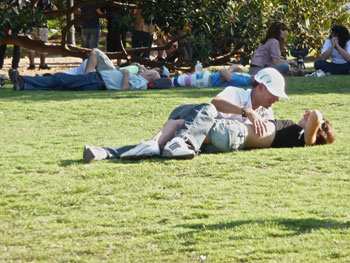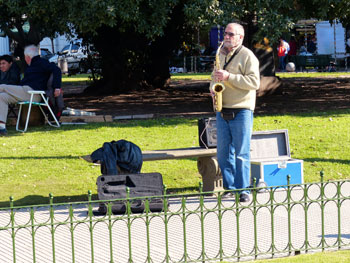What will I do today?
After my friend Celina wakes me up at noon for our daily telephone update, I leave the apartment. With a smiling heart, sunglasses and giant invisible arms, I step out to take a short walk under the blue skies. I feel eager to hug this Buenos Aires I love. I am no different than my compatriots. Porteños are in love with their city no matter how frustrated they might feel about the economy. At this time of the year the city is even more lovable. Impressionistic-brush strokes of jacarandas’ bluish-lilac flowers add this so Buenos Aires color. There is renovation, life and art in the air.
As usual, I head towards my office, the lovely outdoor table at the corners of R. M. Ortiz and M. Quintana. After breakfast at 2:00 PM, with the eagerness of a kid looking for Christmas presents, I open today’s newspaper. I peruse cultural events. I want to go to all of them. I want to play with all my toys. Today’s menu: Susana Rinaldi’s recital, Sexteto Mayor’s performance, and seven or eight other intriguing shows. I choose the four-hour long Argentine film “Inexplicable Stories” which is now showing at the Museum of Latin American Art (MALBA).
My first plan chooses itself
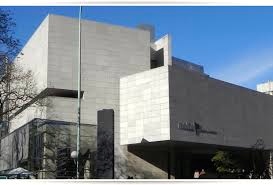 Taxi! Taxi! To MALBA please. I arrive three hours in advance to secure a seat. Oh…No…It has been sold out for three days. I become aware that porteños consume high doses of art. I see it everywhere, no exceptions.
Taxi! Taxi! To MALBA please. I arrive three hours in advance to secure a seat. Oh…No…It has been sold out for three days. I become aware that porteños consume high doses of art. I see it everywhere, no exceptions.
Changing plans, I get tickets for an older Argentine film that is about to begin: “The Other.” I am struck by the movie’s minimalist plot and focus on facial expressions. The director does not hand out meanings. You either figure it out or you don’t. Background music is absent; I love experiencing silence. The few sounds I recollect are the protagonist’s steps, vehicles’ noises and murmur of flowing water. When the protagonist gives a shower to his senile father without uttering words their sweet communication stands out poignantly. The silence of “The Other” reminds me of another Argentine film I saw yesterday, a gem called “La Cámara Oscura,” the “action” happened inside the protagonist’s mind, it was easy to intuit it. What was most important was the un-said.
(Does this bend for interiority and silence in these two Argentine films remind you of tango dancing?).
Are we opinionated!

MALBA is not far from Fondo Nacional de Las Artes. Lured by their excellent cultural events I cross Avenida del Libertador to pick up the program of events. The walk through the greenery of Palermo’s exquisite architecture keeps alive my sense of renovation and art in the air.
The clerk at Fondo Nacional, assuming I was there for an event hands me a free ticket. Free cultural events are everywhere in this city. I just arrived from the USA where I pay for about one hundred percent of events. Free? I give the clerk a puzzled look. She goes on: “Are you attending the Molocznik interview about Jauretche conducted by Horacio Embom? I give her another puzzled look. “It is about Perón and the intellectuals,” she says. I only know Jauretche. “Sure” I replied. If I gain one additional iota of understanding of the Peronist movement quite alive today, it will be worth it, I thought. I do gain new perspectives in lectures or presentations but what fascinates me the most in Buenos Aires is the behavior of the audience. This group, like most, is highly opinionated and highly knowledgeable. People insist in expressing their views, even when the moderator wants to redirect the focus. I cannot resist reporting about just one such example: when the interviewer asked Molocznik when the revolutionary Peronist movement died, someone from the audience answered the question before the invited guess could. And he did it loudly: “When Evita Perón died. Evita was the left hand and Perón was the right hand.” The speaker thought it was an oversimplification but basically agreed with him about Eva Peron being the link to the masses.
Boy! Are we opinionated!
-Weapons of Mass Instruction
I am taking the long walk home from Fondo Nacional de las Artes. Something big and unusual parked at the corner of Las Heras and Libertador calls my attention. It is an actual size war tank-like structure with an inscription on the side. The body of the “vehicle” is fully constructed with old books. At first sight I imagined it was a clever stand to sell old books. No. It was an art piece parked along the curb around the Feria Artesanal Plaza Francia. Its purpose was to make a political statement. The sign “Weapons of Mass Instruction” placed on the street side catches drivers’ attention. I zigzag to avoid the fast traffic in never-ending motion. No traffic lights in this dangerous intersection?
-Creativity in the air
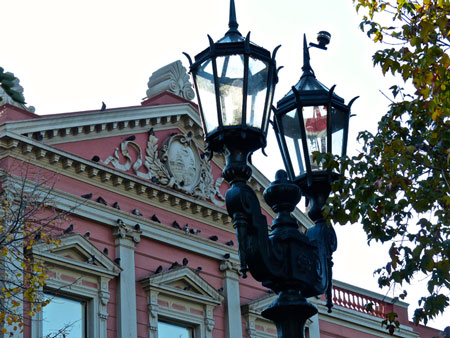 Strolling around Plaza Francia takes me to the Cultural Center of Recoleta. I go inside to pick up the weekly program of events. At any time you are likely to find interesting events happening here. At this moment I could attend the closing of a weeklong jazz festival. It has gone on from the 15th through the 19th of October. Shall I go to the jazz event? No. Sunset is approaching. Enough for today. A slow walk home will close my full day.
Strolling around Plaza Francia takes me to the Cultural Center of Recoleta. I go inside to pick up the weekly program of events. At any time you are likely to find interesting events happening here. At this moment I could attend the closing of a weeklong jazz festival. It has gone on from the 15th through the 19th of October. Shall I go to the jazz event? No. Sunset is approaching. Enough for today. A slow walk home will close my full day.
The soil under my feet
The colonial Iglesia del Pilar looks mysteriously attractive under changing sunset light. Its open doors show off the splendor of its shining gold altar. The sounds of the evening mass reach the street through loudspeakers as the church – filled to capacity – has to reach those standing in its front yard. I think of the early 1700s when the church was built. The soil where it now stands could have been muddy before the Rio de la Plata receded.
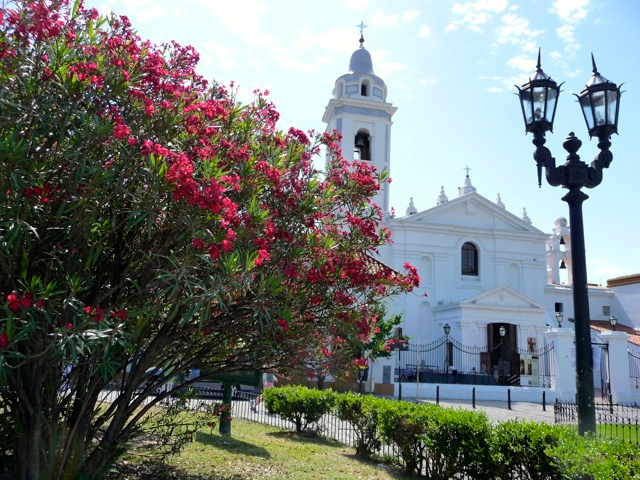
The hundreds of devotees standing inside the church are twenty feet away from hundreds of others on the outside park. Beyond the church fences care free people are concerned with mundane matters. Some have their palms read by Tarot specialists. Some eat street food or drink mate. No popcorn or hot dogs here. Mostly homemade goodies and freshly squeezed juices.
A sense of leisure reminds me of a painting of another time and another place: Georges-Pierre Seurat painting A Sunday afternoon on the island of La Grande Jatte.
I take notice of how sunset light changes the feeling of this place. Gone from my 180 degree visual field are the street tango dancers, the many people that line the lawn green carpet. They will be here tomorrow afternoon. So will the accordion player. So will I. Same place, same time. same appointment with daytime leisurely bohemia.
Feeling a sense of communion with the light, the energy, the jacaranda trees and the vitality of it all, I march towards my apartment and call it a day.
A day of sensations, improvisation, learning and discovery.
Tags: Places

